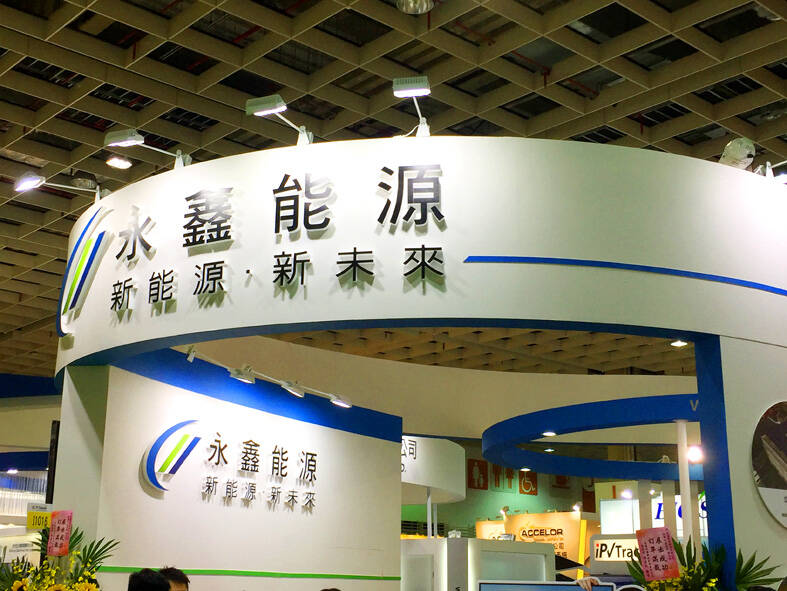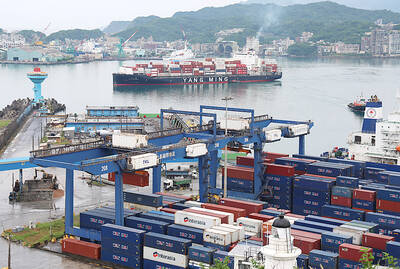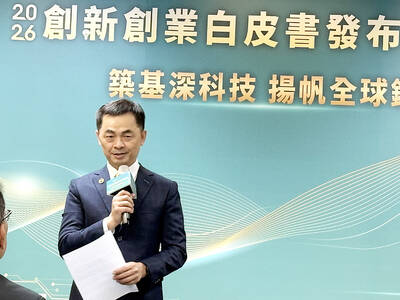Google on Monday said it is planning to invest in New Green Power Co (NGP, 永鑫能源), a solar energy developer owned by BlackRock Inc, to build 1 gigawatt of solar capacity in Taiwan to supply clean energy for its local data center and offices.
“Our investment in NGP, subject to regulatory approval, will serve as development capital toward its 1 GW pipeline of new solar projects, catalyzing critical equity and debt financing for those projects,” Google’s Data Center Energy global head Amanda Peterson Corio wrote on a company blog.
It did not disclose financial details.

Photo: Chang Hui-wen, Taipei Times
“We expect to procure up to 300 megawatts of solar energy from this pipeline through power purchase agreements and the associated energy attribute certificates (Taiwan Renewable Energy Certificates or T-RECs) to help meet electricity demand from our data center campus, cloud region and office operations in Taiwan,” Corio wrote.
Google has been operating a US$600 million data center in Changhua County since 2013.
The company might take a step further by offering a portion of this clean energy capacity to its semiconductor and manufacturing partners in the region so they can advance their sustainability goals while helping Google reduce its Scope 3 emissions, the indirect emissions from its value chain, Corio wrote.
“As we witness growth in demand for digital services, powered by artificial intelligence and data center technologies, it becomes imperative to invest in clean energy,” BlackRock global head of climate infrastructure David Giordano said on the Google blog.
Google’s new solar investment has helped boost the share prices of the nation’s major solar module manufacturers amid expectations that the large-scale clean energy project would stimulate solar module demand locally given Taiwan’s complete solar energy supply chain.
Google’s plan to build 1 gigawatt of solar energy is equal to 40 percent of the nation’s solar energy installation totaling 2.5 gigawatts last year.
The stock prices of Motech Industries Inc (茂迪), TSEC Corp (元晶) and United Renewable Energy Co (聯合再生) yesterday rallied 9.95 percent, 10 percent and 9.81 percent to close at NT$34.25, NT$31.35 and NT$14.55 respectively.
Google’s latest solar energy project could help alleviate the tight supply of green energy in Taiwan.
To address that issue, the Taiwan Photovoltaic Industry Association (台灣太陽光電產業協會) said it has proposed to the nation’s major power users, mostly technology companies, to build their clean energy capacity and most of them agreed.

CHIP RACE: Three years of overbroad export controls drove foreign competitors to pursue their own AI chips, and ‘cost US taxpayers billions of dollars,’ Nvidia said China has figured out the US strategy for allowing it to buy Nvidia Corp’s H200s and is rejecting the artificial intelligence (AI) chip in favor of domestically developed semiconductors, White House AI adviser David Sacks said, citing news reports. US President Donald Trump on Monday said that he would allow shipments of Nvidia’s H200 chips to China, part of an administration effort backed by Sacks to challenge Chinese tech champions such as Huawei Technologies Co (華為) by bringing US competition to their home market. On Friday, Sacks signaled that he was uncertain about whether that approach would work. “They’re rejecting our chips,” Sacks

Taiwan’s exports soared 56 percent year-on-year to an all-time high of US$64.05 billion last month, propelled by surging global demand for artificial intelligence (AI), high-performance computing and cloud service infrastructure, the Ministry of Finance said yesterday. Department of Statistics Director-General Beatrice Tsai (蔡美娜) called the figure an unexpected upside surprise, citing a wave of technology orders from overseas customers alongside the usual year-end shopping season for technology products. Growth is likely to remain strong this month, she said, projecting a 40 percent to 45 percent expansion on an annual basis. The outperformance could prompt the Directorate-General of Budget, Accounting and

NATIONAL SECURITY: Intel’s testing of ACM tools despite US government control ‘highlights egregious gaps in US technology protection policies,’ a former official said Chipmaker Intel Corp has tested chipmaking tools this year from a toolmaker with deep roots in China and two overseas units that were targeted by US sanctions, according to two sources with direct knowledge of the matter. Intel, which fended off calls for its CEO’s resignation from US President Donald Trump in August over his alleged ties to China, got the tools from ACM Research Inc, a Fremont, California-based producer of chipmaking equipment. Two of ACM’s units, based in Shanghai and South Korea, were among a number of firms barred last year from receiving US technology over claims they have

BARRIERS: Gudeng’s chairman said it was unlikely that the US could replicate Taiwan’s science parks in Arizona, given its strict immigration policies and cultural differences Gudeng Precision Industrial Co (家登), which supplies wafer pods to the world’s major semiconductor firms, yesterday said it is in no rush to set up production in the US due to high costs. The company supplies its customers through a warehouse in Arizona jointly operated by TSS Holdings Ltd (德鑫控股), a joint holding of Gudeng and 17 Taiwanese firms in the semiconductor supply chain, including specialty plastic compounds producer Nytex Composites Co (耐特) and automated material handling system supplier Symtek Automation Asia Co (迅得). While the company has long been exploring the feasibility of setting up production in the US to address